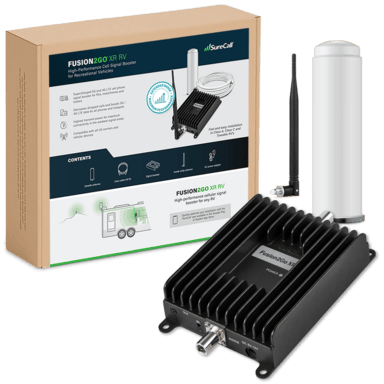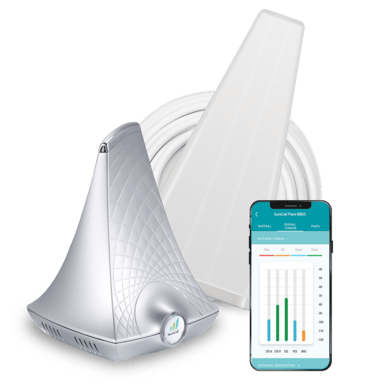
How Far Does Cell Signal Travel? How Cell Signals Work on a Plane
Posted by surecall on 12th Mar 2024
With more airlines relaxing restrictions on in-flight cell phone usage, many travelers wonder if it’s possible to get a reliable cell signal while flying. How far does cell signal travel, and can you get service at cruising altitude? Understanding how cell signals behave in the air helps explain why staying connected on a flight isn’t as simple as on the ground. In this article, we’ll explore how cell signals work, the limitations of cell networks at high altitudes, and whether you can get cell service on a plane.
At What Elevation Can a Cellphone Work?
Despite airline personnel requesting that all phones either be turned off or put in airplane mode, cell phones can continue to work while in the air but only while in the range of a cellular tower. Cellular towers are built to rise hundreds of feet into the air but eventually as the plane continues to move upward it moves out of contact range. The maximum distance which a phone can still make calls and send texts varies on the type of tower and transmitter but a plane would need to be no more than 10,000 feet in the air to receive a signal.
Why Don't Planes Have Regular Cell Service?
Several factors prevent planes from offering regular cell service like you experience on the ground:
- Altitude Limitations: Commercial airplanes cruise at altitudes between 30,000 and 40,000 feet (9,000 to 12,000 meters). At these heights, cell signals from ground towers are too weak to establish a reliable connection. The signal strength diminishes with distance, and the towers are not designed to communicate effectively at such elevations.
- Signal Directionality: Cell tower antennas are configured to broadcast signals horizontally and slightly downward, not upward. This design ensures optimal coverage for ground users but leaves aircraft largely out of reach.
- Rapid Movement: Airplanes travel at speeds of approximately 500 to 600 miles per hour (800 to 965 kilometers per hour). At this velocity, a cell phone would attempt to switch between towers every few seconds, a process known as handoff. The cellular network isn't equipped to handle such rapid handoffs, leading to dropped connections and potential network instability.
- Interference Concerns: There is a risk that active cell phones in the air could cause interference with ground networks. Phones at high altitudes might connect to multiple towers simultaneously, causing confusion within the network and degrading service for ground users.
- Regulatory Restrictions: Regulatory bodies like the Federal Communications Commission (FCC) in the United States restrict in-flight cell phone use to prevent potential interference with aviation systems and ground networks.
To provide regular cell service on planes, airlines would need to install specialized equipment like picocells or femtocells. These are small cellular base stations that create a miniature cell network within the aircraft.
What Else Affects Cellular Signal Other Than Altitude?
As a plane passes over rural areas with small populations, cellular towers are few and far between. Over an ocean, there’s none.
Speed can also make maintaining a cellular signal difficult as your phone switches from tower to tower. Planes would need to be traveling 155 miles or less for phones within cell tower range to make and receive calls.
Can You Get Cell Service on a Plane?
In order for cellphones to operate while in flight, airplanes would need to be equipped with either picocells or cellular signal boosters which would operate through cell phone towers that would be set up to work within airplanes or via satellite.
How Do Cell Signals Work on the Ground vs. in the Air
On the ground, cell phones communicate with nearby cell towers that are part of a vast network designed to provide seamless coverage. These towers emit radiofrequency signals horizontally to cover specific geographic areas, allowing your phone to connect to the network as you move. Buildings, terrain, and other obstacles can affect signal strength, but the infrastructure is optimized to handle these challenges at ground level.
In the air, however, the dynamics change dramatically. As an aircraft ascends, the distance between it and the ground-based cell towers increases significantly. Cell towers are not designed to project signals upward to high altitudes; their antennas are typically tilted downward to maximize ground coverage. Additionally, the curvature of the Earth limits the line-of-sight connection between the plane and the towers. The higher the altitude, the weaker the signal becomes until it eventually fades out of range.
Should the day come where cell phones can be used on most airline flights, SureCall will have the boosters needed to make this happen. To learn more about our cell phone signal boosters to help you get the best signal on the ground, explore our collection of signal boosters here.
Fusion2Go XR RV Cell Phone Signal Booster
Fusion4Home Yagi Panel Indoor Signal Booster





